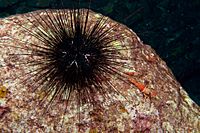Jolthead porgy facts for kids
Quick facts for kids Jolthead porgy |
|
|---|---|
 |
|
| Conservation status | |
| Scientific classification | |
| Synonyms | |
|
The jolthead porgy (Calamus bajonado) is a type of fish that lives in the ocean. It belongs to the family called Sparidae, which includes many kinds of porgies. In different places, this fish has other names. For example, in Bermuda, people call it the blue bone porgy. In the United States, it's sometimes known by its Spanish name, bojanado. And in Jamaica, it's one of the fish called a porgi grunt.
Contents
Discovering the Jolthead Porgy
Two scientists, Marcus Elieser Bloch and Johann Gottlob Schneider, are credited with first describing the jolthead porgy. Bloch passed away in 1799. However, Schneider later edited and published some of Bloch's writings. This work appeared in a book called Systema Ichthyologiae iconibus cx illustratum in 1801.
The fish was first placed in the Sparus group. But it has since been moved to the Calamus group. The name Calamus comes from an old Greek myth. In the story, a character named Calamus turned into aquatic plants. This is fitting because some fish in this group live among these plants.
The species name, bojanado, comes from Spanish words. Bojo means "low" and nado means "swimming". So, it means "low swimming". The common name "jolthead" might come from how these fish eat. They may "jolt" or bump mollusks off rocks to get their food.
Physical Description of the Jolthead Porgy
The jolthead porgy has specific features that help identify it. It usually has 12 rays on its dorsal fin (the fin on its back). It also has 10 rays on its anal fin (the fin on its underside). Its pectoral fins (side fins) typically have 15 rays, but sometimes they can have 14 or 16.
The fish's lateral line (a special sensory line along its side) has between 50 and 57 scales. This is a key difference from most other porgies in its group. Many other Calamus fish have fewer scales, usually 45 to 49. The jolthead porgy also has more pectoral rays than a similar fish called Calamus pennatula.
In terms of color, the jolthead porgy is a brassy silver. It sometimes has a blue-green shimmer. It also has a blue line right under each eye. Its mouth is rimmed with orange. Compared to other fish in its group, it's considered one of the less colorful ones.
The biggest jolthead porgy ever recorded was about 76 centimeters (30 inches) long. They commonly grow to about 54 centimeters (21 inches). While they usually weigh around 8 pounds, the heaviest one found weighed over 23 pounds!
Where Jolthead Porgies Live and What They Eat
Jolthead porgies are found only in the western Atlantic Ocean. They live from Rhode Island and Bermuda all the way south to Brazil. They are very common in the northern Gulf of Mexico and the West Indies.
These fish prefer clear, shallow waters, often around seagrass beds. They usually swim in depths up to 150 feet. However, they have been seen as deep as 180 to 200 meters (about 600 feet). Jolthead porgies are usually solitary, meaning they swim alone. But sometimes, you might see them in schools near reefs. They are thought to lay their eggs in July and August.

There's some discussion about what jolthead porgies eat. Some experts say they are omnivores, meaning they eat both plants and animals. Others believe they mainly eat other animals. These animals include sea urchins (especially those from the Diadema group), mollusks, and crustaceans.
Jolthead Porgies and People
Many people consider the jolthead porgy to be a very good fish to eat. They are fairly easy to catch using a hook and line from the bottom of the ocean. People also catch them using fish traps.
These fish are popular for sport fishing. They also have some importance in commercial fishing. However, there have been reports of people getting sick from ciguatera poisoning after eating them. This can happen when the fish eat tiny ocean plants called dinoflagellates during events sometimes called "red tides."
See also
 In Spanish: Calamus bajonado para niños
In Spanish: Calamus bajonado para niños




